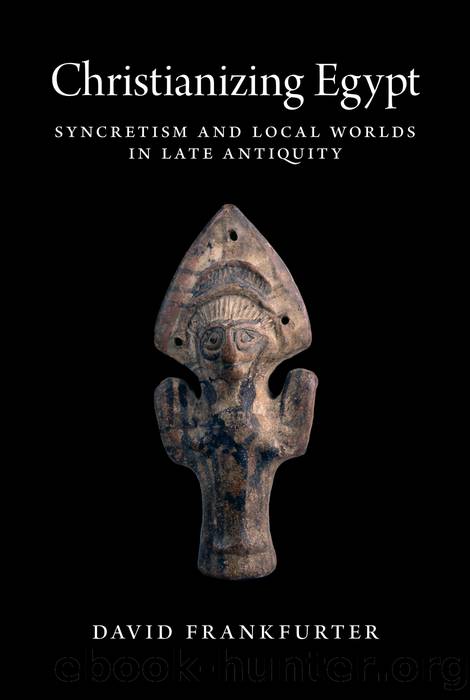Christianizing Egypt by Frankfurter David

Author:Frankfurter, David [Frankfurter, David]
Language: eng
Format: epub
ISBN: 9780691176970
Publisher: PrincetonUP
Published: 2017-07-15T05:00:00+00:00
C. Painters
Painters, as masters both in the deployment of color and in producing the visual image, also sought efficacyâthe power of an object to transform spaces and create âpresenceââindeed, to instill power in an image. Colors and their juxtapositions, gestures, the detailing of eyes, and the general creation of otherworldly spectacleâthe use of all these tools comprised the painterâs craft as it came to integrate Christian themes with traditional strategies. Like the terracotta figurines of the early Roman period, portable panel paintings of Egyptian gods developed around the same time as alternative media for worshipping Egyptian gods and interpreting them within the domestic sphere.93 The innovations in both cases came from workshops, which combined Greco-Roman styles of representation with locally valued gods to create more affordable and portable images for private shrines and votive offerings for temples.94 The versatility of these second- and third-century painters was considerable. The panel paintings, which were set in wood frames for hanging on a wall in a house or temple atrium (see plate 8), are complemented by a number of wall murals in the same style from houses in the Fayyum towns of Tebtunis and Karanis, and several of the panels seem to have functioned as doors to traditional shrine boxes, or naoi.95 All these applications of the new medium show the interests of painters in extending this medium to different domains of religious practice and experienceâdomains in which devotions might have taken the form of hanging garlands, placing lamps, or lighting incense, all of which are mirrored in some of the panel paintings.96 While mostly unprovenanced, the âpantheonâ of painted images shows some consistency: Isis in her lactans pose with Harpocrates (an image found especially in Karanis), the military god Heron (plate 8), the crocodile god Soknebtunis as lord over other gods, a solitary Harpocrates, and several other divinities both Egyptian and Hellenistic all appear frequently. As other workshops were doing with images of the deceased (the so-called portrait mummies), the painters of these images depicted the gods in a Hellenistic style that emphasized the accoutrements of cultural prestige in dress, jewelry, crowns, hairstyles, and thrones, as well as the frontality that typically accentuated both familiarity and presence, contributing to what Elsner called a âritual-centeredâ visuality.
It is in this frontality that we can begin to grasp the particular efficacy of the panel paintings as well as their likely role as the inspiration for the earliest Christian panel icons. If we recall the positions of Egyptian divinities represented outside temples, the potency of the body and of the frontal gaze was usually downplayed to stress ritual relationships, mythic accoutrements, and the presence of the pharaoh. (Relief images of Hathor and Bes offer notable exceptions.97) While the innovation of the molded terracotta figurines accentuated the body and its mysteries and potencies in the round, the panel paintings of gods brought forth the frontal gaze (even if the eyes of the subjects are often slightly averted). Indeed, except for a very few images seeking to mimic
Download
This site does not store any files on its server. We only index and link to content provided by other sites. Please contact the content providers to delete copyright contents if any and email us, we'll remove relevant links or contents immediately.
The History of Jihad: From Muhammad to ISIS by Spencer Robert(2575)
Nine Parts of Desire by Geraldine Brooks(2328)
The Turkish Psychedelic Explosion by Daniel Spicer(2314)
The First Muslim The Story of Muhammad by Lesley Hazleton(2222)
The Essential Rumi by Coleman Barks(1992)
1453 by Roger Crowley(1974)
The Last Mughal by William Dalrymple(1834)
Trickster Travels: A Sixteenth-Century Muslim Between Worlds by Davis Natalie Zemon(1815)
God by Aslan Reza(1616)
Muhammad: His Life Based on the Earliest Sources by Martin Lings(1609)
by Christianity & Islam(1596)
A Concise History of Sunnis and Shi'is by John McHugo(1547)
Magic and Divination in Early Islam by Emilie Savage-Smith;(1501)
No God But God by Reza Aslan(1500)
The Flight of the Intellectuals by Berman Paul(1466)
Art of Betrayal by Gordon Corera(1403)
Nothing to Envy by Barbara Demick(1389)
What the Qur'an Meant by Garry Wills(1363)
Getting Jesus Right: How Muslims Get Jesus and Islam Wrong by James A Beverley & Craig A Evans(1312)
